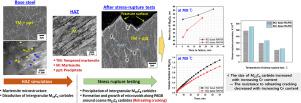Journal of Nuclear Materials ( IF 2.8 ) Pub Date : 2020-09-08 , DOI: 10.1016/j.jnucmat.2020.152499 Joonoh Moon , Jin-Jong Lee , Chang-Hoon Lee

|
Reduced activation ferritic–martensitic steels with different Cr contents were prepared to investigate the effect of Cr on the reheating cracking susceptibility in the weld heat-affected zone (HAZ). After HAZ simulation, stress-rupture tests were performed at 650–750°C, corresponding to the post-weld heat treatment temperature, using a Gleeble simulator. Increasing the Cr content markedly reduced the rupture ductility, resulting in an increase in the susceptibility to reheating cracking. This was attributed to the intergranular Cr-enriched M23C6 carbides that precipitated along the prior austenite grain boundaries during rupture testing, which acted as crack initiation sites. The size of these carbides increased with increasing Cr content, indicating that an increase in Cr contents easily facilitates formation and growth of microvoids that promote reheating cracking during rupture testing.
中文翻译:

还原活化铁素体-马氏体钢的焊接热影响区的再加热裂纹敏感性和Cr含量的影响
制备了具有不同Cr含量的还原活化铁素体-马氏体钢,以研究Cr对焊缝热影响区(HAZ)的再热开裂敏感性的影响。经过HAZ模拟后,使用Gleeble仿真器在650-750°C(对应于焊接后热处理温度)下进行了应力断裂测试。Cr含量的增加显着降低了断裂延展性,导致对再热裂纹的敏感性增加。这归因于晶间富Cr M 23 C 6。在断裂测试期间沿着先前的奥氏体晶界析出的碳化物,充当裂纹的起始点。这些碳化物的尺寸随Cr含量的增加而增加,表明Cr含量的增加容易促进微孔的形成和生长,从而促进断裂试验期间的再热裂纹。











































 京公网安备 11010802027423号
京公网安备 11010802027423号